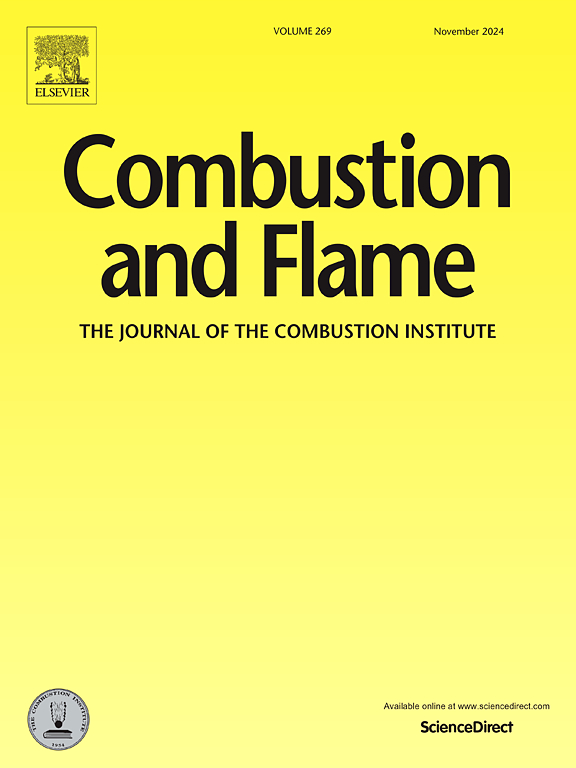Fundamental investigation of methanol flash boiling combustion under direct injection conditions
IF 5.8
2区 工程技术
Q2 ENERGY & FUELS
引用次数: 0
Abstract
The task of reducing carbon emissions has become a primary goal for energy utilization purposes via combustion. The use of e-fuels/alternative fuels is a viable solution to enable zero carbon emission during the life cycle. However, the combustion of such fuels, such as methanol, is somehow different from combusting gasoline or diesel in the aspects of fuel atomization/evaporation and combustion mechanisms, etc. Flash boiling atomization is a promising atomization approach for improving the atomization and evaporation of alcohol fuels. The use of flash boiling atomization has been validated in optical gasoline direct injection (GDI) engines. However, the fundamental understanding of the impact of flash boiling on fuel combustion is still missing. This investigation focuses on the combustion of methanol fuel in a constant volume combustion chamber in a GDI fuel-air mixing fashion. The spray and flame propagation characteristics are obtained via high-speed imaging. Furthermore, detailed combustion product analysis is carried out using an online Fourier transform infrared (FTIR) device to distinguish the fundamental difference when combusting the fuel under sub-cooled and flash boiling conditions. Soot produced during the combustion is collected by mesh grids and analyzed via a transmission electron microscope (TEM). The results show that flash boiling promotes combustion efficiency under rich combustion conditions. Compared to sub-cooled combustion, methanol flash boiling combustion increases CO/CO2 emissions by 11.8 % and aldehydes emissions by 19.3 %, while reducing unburned hydrocarbons by approximately 30 %. NOx and aromatics emissions are decreased under methanol flash boiling combustion by 49.7 % and 55.1 %, respectively. Compared to n-heptane, methanol sub-cooled combustion reduces the production of soot particles. The stronger oxidation effect of methanol suppresses nuclei-mode soot generation, and the soot particles from methanol combustion feature shorter, more compact, and orderly stacked graphene layers. Moreover, flash boiling atomization further inhibits soot formation from methanol combustion.
直接喷射条件下甲醇闪沸燃烧的基础研究
减少碳排放的任务已经成为通过燃烧实现能源利用的主要目标。使用电子燃料/替代燃料是实现生命周期零碳排放的可行解决方案。但是,甲醇等燃料的燃烧在燃料雾化/蒸发和燃烧机理等方面与燃烧的汽油或柴油有某种不同。闪速沸腾雾化是一种很有前途的改善酒精燃料雾化和蒸发的雾化方法。在光学汽油直喷(GDI)发动机上验证了闪蒸雾化的应用。然而,对闪沸对燃料燃烧的影响的基本认识仍然缺乏。本研究的重点是甲醇燃料的燃烧在定容燃烧室在GDI燃料-空气混合的方式。通过高速成像获得了喷雾和火焰的传播特性。此外,利用在线傅里叶变换红外(FTIR)装置进行了详细的燃烧产物分析,以区分燃料在过冷和闪沸条件下燃烧的根本区别。燃烧过程中产生的烟尘由网格收集,并通过透射电子显微镜(TEM)进行分析。结果表明,在丰富的燃烧条件下,闪沸有利于提高燃烧效率。与过冷燃烧相比,甲醇闪沸燃烧增加了11.8%的CO/CO2排放量和19.3%的醛类排放量,同时减少了约30%的未燃烧碳氢化合物。甲醇闪速沸腾燃烧的NOx和芳烃排放量分别减少了49.7%和55.1%。与正庚烷相比,甲醇过冷燃烧减少了烟尘颗粒的产生。甲醇较强的氧化作用抑制了核模烟尘的生成,甲醇燃烧产生的烟尘颗粒具有更短、更致密、更有序地堆叠石墨烯层的特征。此外,闪蒸雾化进一步抑制了甲醇燃烧产生的烟尘。
本文章由计算机程序翻译,如有差异,请以英文原文为准。
求助全文
约1分钟内获得全文
求助全文
来源期刊

Combustion and Flame
工程技术-工程:化工
CiteScore
9.50
自引率
20.50%
发文量
631
审稿时长
3.8 months
期刊介绍:
The mission of the journal is to publish high quality work from experimental, theoretical, and computational investigations on the fundamentals of combustion phenomena and closely allied matters. While submissions in all pertinent areas are welcomed, past and recent focus of the journal has been on:
Development and validation of reaction kinetics, reduction of reaction mechanisms and modeling of combustion systems, including:
Conventional, alternative and surrogate fuels;
Pollutants;
Particulate and aerosol formation and abatement;
Heterogeneous processes.
Experimental, theoretical, and computational studies of laminar and turbulent combustion phenomena, including:
Premixed and non-premixed flames;
Ignition and extinction phenomena;
Flame propagation;
Flame structure;
Instabilities and swirl;
Flame spread;
Multi-phase reactants.
Advances in diagnostic and computational methods in combustion, including:
Measurement and simulation of scalar and vector properties;
Novel techniques;
State-of-the art applications.
Fundamental investigations of combustion technologies and systems, including:
Internal combustion engines;
Gas turbines;
Small- and large-scale stationary combustion and power generation;
Catalytic combustion;
Combustion synthesis;
Combustion under extreme conditions;
New concepts.
 求助内容:
求助内容: 应助结果提醒方式:
应助结果提醒方式:


